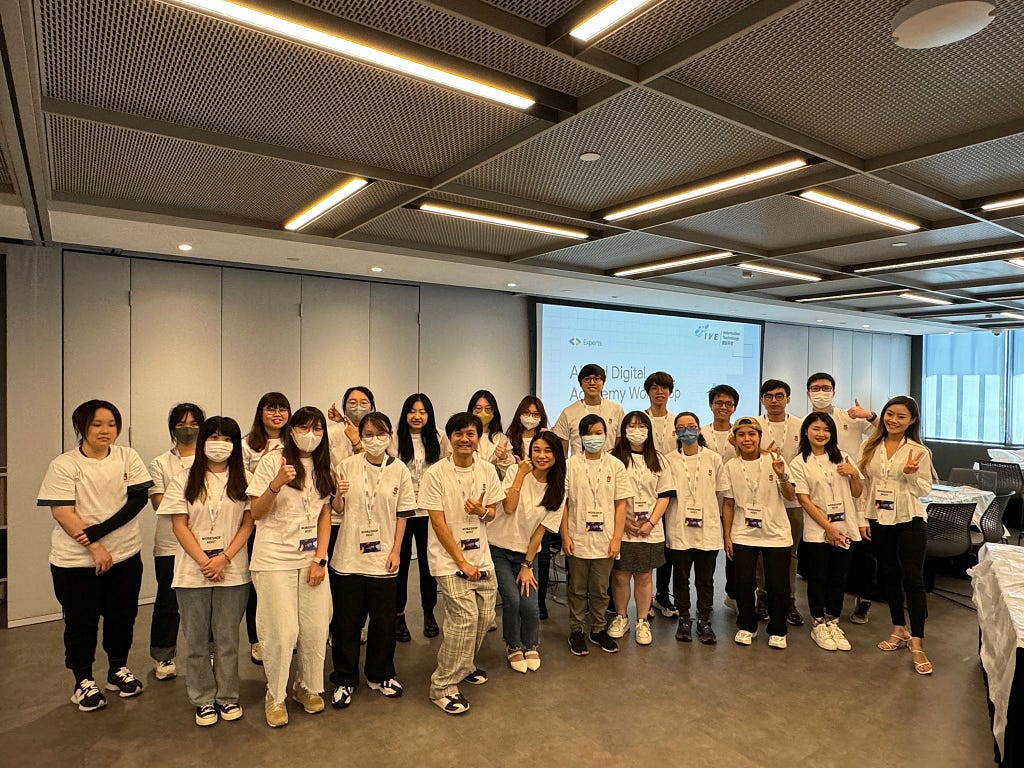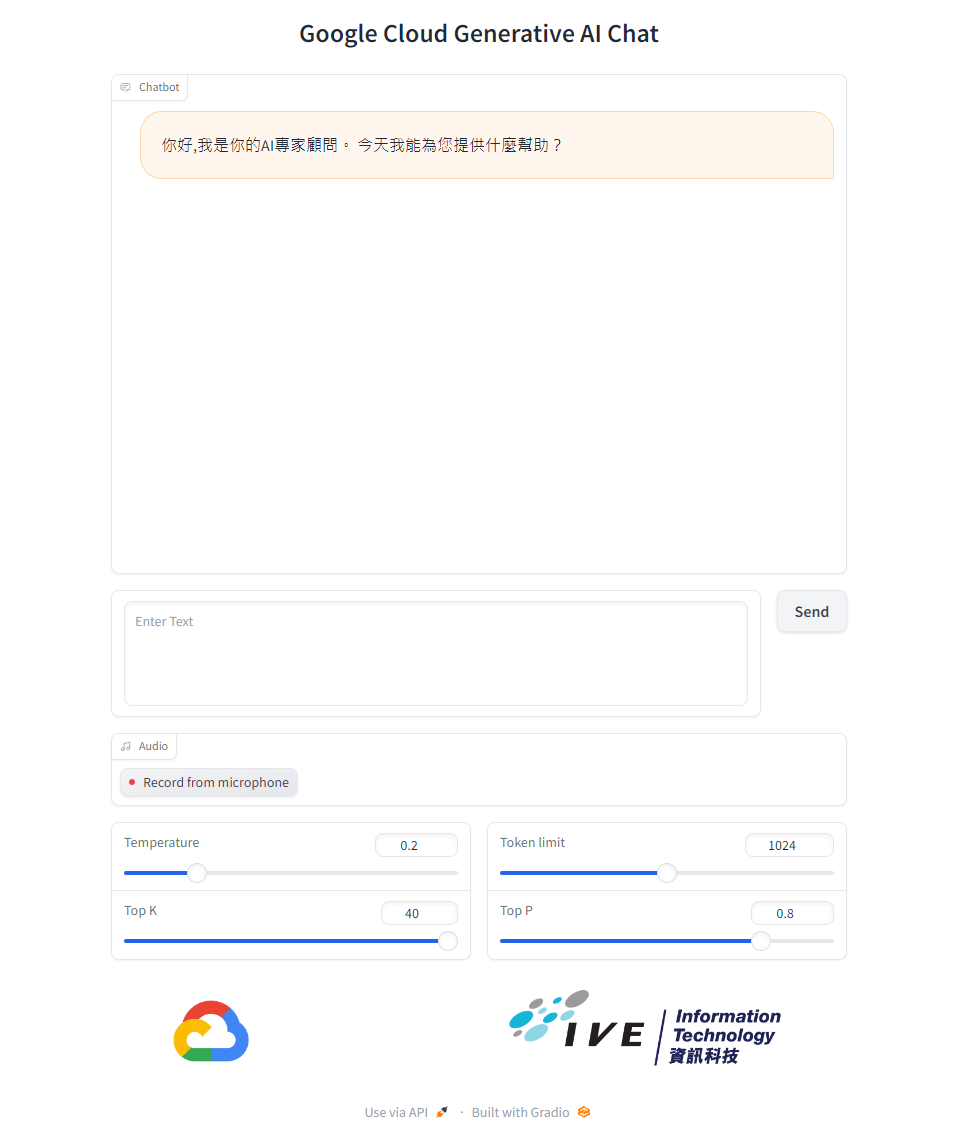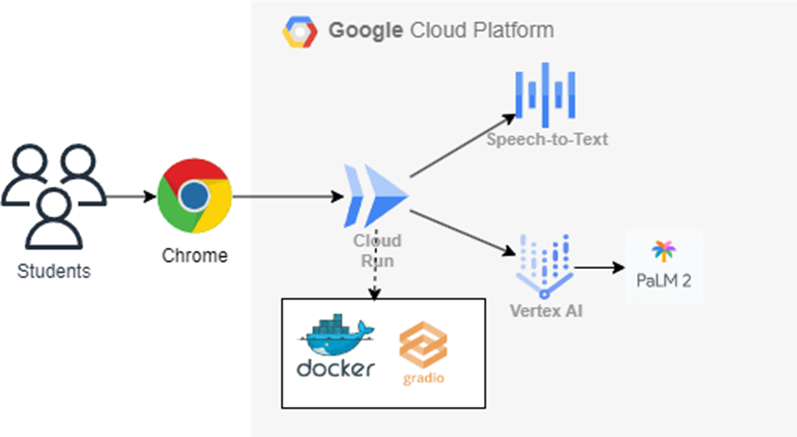Introduction
It is not practical to ask students to create a free Google Cloud Platform account in order to try the Vertex AI PaLM API for chat, as this requires their own credit card. Additionally, not all students may be proficient typists. In order to teach prompt engineering, students need the ability to change token limit, temperature, top-p, and top-k. Therefore, there is a need for a user interface (UI) to assist with the student workshop.


Architecture

The Gradio Web Application enables students to interact with the Chatbot by typing or speaking. This application is hosted on CloudRun to reduce operational expenses. The Gradio application utilizes Vertex AI and the Speech-to-Text API for its functionality.
from fastapi import FastAPI
import gradio as gr
import config as cfg
import logging
import google.cloud.logging
from google.cloud import speech
import vertexai
from vertexai.preview.language_models import ChatModel, ChatMessage
logger = logging.getLogger()
logging_client = google.cloud.logging.Client()
logging_client.setup_logging()
vertexai.init(location="us-central1")
chat_model = ChatModel.from_pretrained("chat-bison-32k")
def transcribe_file(speech_file: str) -> speech.RecognizeResponse:
"""Transcribe the audio file."""
text = ""
client = speech.SpeechClient()
with open(speech_file, "rb") as audio_file:
content = audio_file.read()
audio = speech.RecognitionAudio(content=content)
config = speech.RecognitionConfig(
encoding=speech.RecognitionConfig.AudioEncoding.LINEAR16,
language_code="yue-Hant-HK"
)
response = client.recognize(config=config, audio=audio)
# Each result is for a consecutive portion of the audio. Iterate through
# them to get the transcripts for the entire audio file.
for result in response.results:
# The first alternative is the most likely one for this portion.
text = result.alternatives[0].transcript
logger.info(f"Transcript: {text}")
return text
def add_user_input(history, text):
"""Add user input to chat hostory."""
history = history + [(text, None)]
return history, gr.TextArea(
value="", show_label=False, placeholder=cfg.bot["text_placeholder"], lines=4
)
def bot_response(history):
"""Returns updated chat history with the Bot response."""
# Intergate with ML models to load response.
parameters = {
"temperature": temperture.value,
"max_output_tokens": token_limit.value,
"top_p": top_p.value,
"top_k": top_k.value
}
text = history[-1][0]
# trim text and check if it is empty
text = text.strip()
if not text:
history[-1][1] = "Please tell me something and click send button."
return history
message_history = []
for row in history[1:]:
input_from_user = row[0]
output_from_llm = row[1]
if output_from_llm is not None and input_from_user is not None:
q_message = ChatMessage(author="user", content=input_from_user)
message_history.append(q_message)
a_message = ChatMessage(author="llm", content=output_from_llm)
message_history.append(a_message)
logger.info(message_history)
chat = chat_model.start_chat(
context="""Your name is a helpful assistant.
Respond in short sentences. Shape your response as if talking to a 16-years-old.""",
message_history=message_history
)
response = chat.send_message(text, **parameters)
history[-1][1] = response.text
return history
with gr.Blocks() as bot_interface:
with gr.Row():
gr.HTML(cfg.bot["banner"])
with gr.Row():
chatbot = gr.Chatbot(
[(cfg.bot["initial_message"], None)], elem_id="chatbot", height=500)
with gr.Row():
with gr.Column(scale=12):
user_input = gr.TextArea(
show_label=False, placeholder=cfg.bot["text_placeholder"], lines=4
)
with gr.Column(scale=1, min_width=70):
submitBtn = gr.Button("Send")
with gr.Row():
audio_input = gr.Audio(source="microphone", type="filepath")
with gr.Row():
with gr.Column():
temperture = gr.Slider(
0, 1, step=0.1, label="Temperature", value=0.2, interactive=True)
top_k = gr.Slider(0, 40, step=1, label="Top K",
value=40, interactive=True)
with gr.Column():
token_limit = gr.Slider(
0, 8192, step=1, label="Token limit", value=2048, interactive=True)
top_p = gr.Slider(0, 1, step=0.1, label="Top P",
value=0.8, interactive=True)
with gr.Row():
gr.HTML(cfg.bot["footer"])
input_msg = user_input.submit(add_user_input, [chatbot, user_input], [chatbot, user_input], queue=False)
.then(bot_response, chatbot, chatbot)
.then(lambda: gr.TextArea(
show_label=False, placeholder=cfg.bot["text_placeholder"], lines=4
),
None, [user_input], queue=False)
submitBtn.click(add_user_input, [chatbot, user_input], [chatbot, user_input], queue=False)
.then(bot_response, chatbot, chatbot)
inputs_event = audio_input.stop_recording(transcribe_file, audio_input, user_input)
.then(add_user_input, [chatbot, user_input], [chatbot, user_input], queue=False)
.then(bot_response, chatbot, chatbot)
.then(lambda: gr.TextArea(
show_label=False, placeholder=cfg.bot["text_placeholder"], lines=4
),
None, [user_input], queue=False)
bot_interface.title = cfg.bot["title"]
# bot_interface.launch(share=True,server_name="0.0.0.0")
app = FastAPI()
app = gr.mount_gradio_app(app, bot_interface, path="https://medium.com/")
Source Repo
https://github.com/wongcyrus/google-cloud-voice-activated-chatbot
Deployment
gcloud auth login
gcloud config set project XXXXX
gcloud config set run/region asia-east2
gcloud services enable speech.googleapis.com
gcloud services enable aiplatform.googleapis.com
gcloud run deploy
References:
How to quickly build a voice-activated chatbot to interact with Vertex AI models
Author

Cyrus Wong is an accomplished senior lecturer who oversees the Higher Diploma program in Cloud and Data Centre Administration at the Department Information Technology of IVE(Lee Wai Lee) in Hong Kong. He is a passionate advocate for the adoption of cloud technology across various media and events. With his extensive knowledge and expertise, he has earned prestigious recognitions such as AWS Machine Learning Hero, Microsoft Azure MVP, and Google Developer Expert for Google Cloud Platform.
Connecting me: LinkedIn YouTube GitHub Twitter
Google Cloud Voice Activated Chatbot for Student Workshop was originally published in Google Developer Experts on Medium, where people are continuing the conversation by highlighting and responding to this story.




![[feb-2025]-ai-community — activity-highlights-and-achievements](https://prodsens.live/wp-content/uploads/2025/03/32806-feb-2025-ai-community-activity-highlights-and-achievements-380x250.png)
